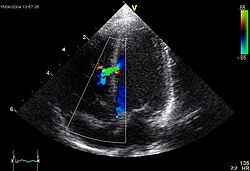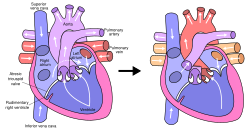Pulmonary atresia
Pulmonary atresia is a congenital birth defect of the pulmonary valve in which the valve does not develop. The valve is completely closed making it harder for blood to travel from the heart to the lungs.
Anatomy
The pulmonary valve is located on the right side of the heart between the right ventricle and pulmonary artery. In a normal functioning heart, the opening to the pulmonary valve has three flaps that open and close; however with this defect some of the flaps are not formed.[1]
Symptoms
The symptoms of pulmonary atresia that would happen in babies include fatigue and shortness of breath.[2]
Complications
Pulmonary atresia can be fatal if no emergency surgery is done. If surgery is done, most children affected by this can live normally, though problems like strokes, heart diseases and seizures are possible.[3]
Pulmonary Atresia Media
Related pages
References
- ↑ "Pulmonic Valve Anatomy: Overview, Pathophysiologic Variants". 2017-09-14.
{{cite journal}}: Cite journal requires|journal=(help) - ↑ "Pulmonary atresia: MedlinePlus Medical Encyclopedia". www.nlm.nih.gov. Retrieved 2016-05-27.
- ↑ Abuhamad, Alfred Z.; Chaoui, Rabih (2012-03-28). A Practical Guide to Fetal Echocardiography: Normal and Abnormal Hearts. Lippincott Williams & Wilkins. pp. 185–86. ISBN 9781451147803.



